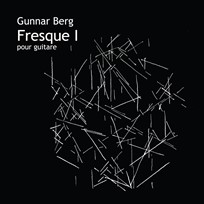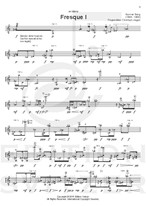Item details
-
Description +
-
Duration: 5 min.
Edited by Christoph Jäggin
Performing artist: Maria Kämmerling
Gunnar Berg (1909-1989) is a unique figure in contemporary Danish music, and the first decisive period of his professional life bore early witness to this. At an early stage he adopted an international orientation and in 1948 he travelled to Paris to study with Arthur Honegger, and quickly Berg gained access to the circle around Olivier Messiaen and thus became part of the international modernist environment in post-war Europe.
It was certainly not on the cards that Gunnar Berg was to write masterpieces of 20th century music for guitar. He had no previous experience of the instrument, and he had always refused to compose for the guitar by quoting Berlioz in the chapter on the guitar in his famous Traité d'Instrumentation (1843): »On ne peut, je le répète, sans en jouer écrire pour la Guitare.«
The German-born guitarist Maria Kämmerling did not accept this explanation, when she heard some of Berg's music in Denmark in 1976. She insisted, and Berg was persuaded to let her introduce him to the instrument. For the next year they jointly explored the guitar and discovered new, unusual and different, boundary-breaking tonal landscapes as well as new techniques of playing and expressions with the experimental attitude so characteristic for Berg’s artistic creativity. With its array of quarter-tones, previously unheard combinations of harmonics and an extreme spectrum of dynamics and stroke types Berg’s guitar music belongs to the most concentrated works that modern guitar music has to offer.
This unusually fruitful collaboration between composer and musician resulted in following works:
• Fresque I-IV for solo guitar (1976-78). Recorded by Maria Kämmerling for PAULA Records - PACD09
• Hyperion for soprano, guitar and 9 instruments (1978)
• Melos for solo guitar (1979). Recorded by Per Dybro Sørensen for Dacapo Records - 8.226526
• 9 Duos for flute and guitar (1957/1984). Recorded by Bolette Roed and Per Dybro Sørensen for Dacapo Records - 8.226526. Published by Edition Svitzer
• Ar-Goat (1984-85) for guitar duo. Recorded by Duo Norman/Dybro for Dacapo Records - 8.226526
In 1985 the Swiss guitarist Christoph Jäggin met Gunnar Berg, and since then he has worked intensively on Berg and his works for guitar, which he describes as follows: “In number, diversity and variety they form an astonishing totality that is not oriented towards the traditional guitar repertoire, yet still seems to have listened thoroughly to the instrument and to have grown organically out of it. More than anything, these compositions are characterized by a profound seriousness and sincerity that is far removed from any superficial amenability.”
-
-
Instrumentation +
-
Guitar
-
-
About the composer +
-
In 2009, the 100th anniversary of the birth of Gunnar Berg (1909-1989) sparked a rediscovery and reassessment of the Danish composer as one of the most important Danish representatives of musical modernism on the international scene. More than 50 performances and events were held in Denmark, Germany, Austria, Switzerland, Finland, Ukraine, USA, China, France, Northern Ireland and Scotland. Berg’s music was played, discussed and written about to an extent never experienced by Berg, himself, in his lifetime. His drawings were also exhibited and his music was released both in print and on CD.
Gunnar Berg was born in St. Gallen in Switzerland on 11 January 1909, the oldest of four siblings. From 1890 his Danish father Sigvard Berg worked on the railway construction in Switzerland, but he died of a heart attack in 1914, only 60 years old. Consequently Berg’s youth in Switzerland and in Denmark was difficult, marked as it was by illness and frequent moves, and without much contact with music.
In 1934 Berg graduated from a business school in Copenhagen, despite having been so deeply affected by a 1931 performance of Wagner’s Tannhäuser at the Royal Theatre that he vowed to devote his life to music. In the summer of 1932 Berg bicycled from Copenhagen to Salzburg, and during the music festival he attended a course given by Austrian music critic Paul Stefan at the Mozarteum. The course opened doors for Berg; he attended rehearsals, concerts and other courses as well as experienced decisive first encounters with the music of composers such as Debussy, Schönberg and Stravinsky. Berg returned to Salzburg in 1935, where he was granted access to rehearsals and concerts led by Arturo Toscanini and Bruno Walter, and where he attended the conductor course by Herbert von Karajan, with whom he had private meetings.
Berg’s time in Salzburg was of landmark importance to his musical orientation, for thereafter he was positioned closer to the music culture of Europe rather than to one that embodied a Danish-Nordic aesthetic. His stays in Salzburg certainly contrasted with his studies at the Royal Danish Academy of Music in Copenhagen in 1936 where his idea of establishing a study group for new music was met with blank refusal from the conservatory. He left at the end of the year, but continued to study piano with the pianist and composer Herman D. Koppel until 1943. From 1944 on Berg studied with Elizabeth Jürgens, an unusually gifted piano teacher of Swedish birth who had lived in Copenhagen for decades.
During the German occupation, Berg actively took part in the rescue of Danish Jews - transporting them to Sweden - and in the Danish resistance movement. After the liberation he was involved in music teaching projects at numerous refugee camps in Denmark and gave concerts featuring his own compositions, classics, and new music including works by Stravinsky, Satie and Honegger.
Berg’s first works date from the mid-1930s; Zehn japanische Holzschnitte (Ten Japanese Woodcuts) for voice and piano from 1938 is considered his first major work, and the three sonatas - for flute and clarinet (1942), for violin (1945) and for piano (1945-47) - with which Berg in the 1940s finally left classical formal structures behind, are significant contributions to this genre within the neoclassical style.
In January 1945 the autodidact composer debuted in Copenhagen, but Berg won no recognition for his music so he began to prepare to go abroad, and in autumn 1948 he went to Paris in order to study with Arthur Honegger at École normale. Berg quickly gained access to the circle around Olivier Messiaen and thus became part of the international modernist environment in post-war Europe. In 1950, at the invitation of Darius Milhaud, he attended the Salzburg Seminar in American Studies, and in 1952 he married the French pianist Béatrice Duffour. They spent their honeymoon at the International Summer Courses for New Music in Darmstadt, where Berg’s meeting with Karlheinz Stockhausen served to confirm the validity and contemporaneity of Berg’s own musical experiments. The couple made a number of concert tours around Europe featuring music of the leading composers of the time. In 1957 and 1958, funded by the French Ministry of Foreign Affairs, they toured Germany and Scandinavia, and then settled in Denmark. For a number of years thereafter the Berg couple embarked on a unique project with residences, lectures and concerts at the Danish Folk High Schools. In 1965 they established their first own home in the old school in Lindved, a very small village located between Horsens and Juelsminde in Jutland. There they created an unusual cultural venue where the people of the region were often invited to memorable concerts with contemporary and classical music. Béatrice Berg died 1976, and in 1979 Gunnar Berg returned to Europe and finally settled in Switzerland, where he experienced a significant surge of interest in his music. Gunnar Berg died in Bern, Switzerland, on 28 August 1989, and he and Béatrice Berg are both buried at the Rårup churchyard, close to their home in Lindved.
The 10-year stay in Paris proved crucial to Berg, and from 1950 he uncompromisingly, yet in his very own fashion, remained faithful to the complex expressive mode of musical modernism within the theoretical and aesthetic framework of serialism, and, it should be noted, without turning dogmatic.
Only very rarely did Gunnar Berg add analytical or explanatory comments to his music: “My works must stand on their own feet, and they must answer for themselves,” he asserted. However, among his posthumous papers there is a wealth of slips of paper with columns of figures and letters, note names, volumes and durations, which provide us some insight into his composition workshop. They also confirm the limited number of analyses of Gunnar Berg’s works that have attempted to map out his working method. Berg’s point of departure was Olivier Messiaen’s division of the twelve chromatic notes of the tempered scale into groups, the so-called “modes with restricted transpositions,” but expanded to apply to all the parameters of the music. The result is a meticulously calculated structuring of durations, pitches, volumes and instrumentation, which was a major theme in Darmstadt in 1952. Berg described his method as “static”, and he spoke of ground rules where, by means of techniques such as mirroring, reversal and transposition, he established a basic body of material to be ordered in his own, personal way.
Gunnar Berg came too late to his study of piano to attain a professional career as a pianist. However, his experiences at the piano decisively influenced his compositional thinking as reflected in his piano compositions – from the numerous small educational pieces to the four virtuoso concertos for piano and symphony orchestra: Essai acoustique (1954), Pour piano et orchestra (1959), Frise (1961) and Uculang (1967). The two major works for solo piano - Eclatements (1954-88) and Gaffky’s (1958-59) - both large compositions, are among the most important contributions to Danish piano literature in the second half of the twentieth century.
This is also the case with his contributions to Danish guitar literature after his meeting with Maria Kämmerling in 1976 which resulted in Fresque I-IV (1978), Hyperion (1978) for guitar, soprano and 9 instruments, Melos (1979) for solo guitar and Ar-Goat (1984) for guitar-duo.
-
-
Credits +
-
Foreword and front cover graphics: Jens Rossel
Front cover: Drawing by Gunnar Berg
Photo of Maria Kämmerling and Gunnar Berg: Knud Nielsen
Editing and engraving: Christoph Jäggin
Afterword and editorial emendations (in German): Christoph Jäggin
Translation to Danish: Per Bærentzen
Published in cooperation with Working Group Gunnar Berg
www.gunnarberg.dk / www.editionsvitzer.com
-





